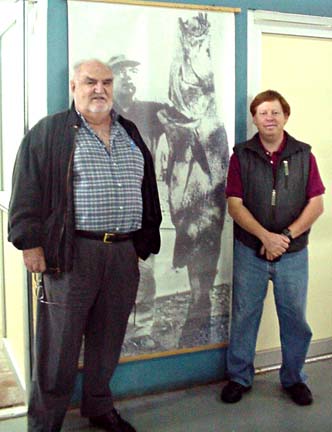
Historic Totoaba Meeting in Ensenada
![]()
|
FINALLY, THEY MEET--Julio Berdegué (left) and Universidad Autonoma de Baja California Totoaba Program Director Conal David True with a lifesized totoaba photo at the university's breeding lab at Ensenada, Baja California, Mexico. |
TOTOABA BIOLOGISTS FROM DIFFERENT ERAS MEET AT ENSENADA LAB
By Gene Kira, December 8, 2003, as published in Western Outdoor News:
About 11 a.m. on a Friday morning recently, I got an urgent call from Conal David True, director of the totoaba breeding program at the Universidad Autonoma de Baja California (UABC) lab at Ensenada, Baja California, Mexico. Conal was fairly out of breath, and I could imagine him sprinting up the stairs to his office overlooking the big fish tanks. Conal's voice was excited, but hushed:
"Gene...he's coming."
"Are you positive?"
"I just talked to him."
"Okay, I'll be there for sure. When is he coming?"
"In about half-an-hour."
"...whaaat?"
|
|
Unfortunately, Don Julio Berdegué--whose movements are sometimes a bit whimsical and hard to track--hadn't bothered to call from his El Cid Mega Resort in Mazatlán, nor had he called from the airport in San Diego.
As near as I can figure it, the damned Julio had finally called, via cell phone, from the Ensenada toll road as he and his retinue sped southwards, quite possibly in several vehicles, somewhere around Rosarito Beach.
And so, I missed the historic first meeting of the two men in history who have done the most to help save the endangered totoaba--the giant croaker that grows as big as a marlin--from extinction.
This meeting was remarkable for several reasons, not the least of which being the mere fact that Julio Berdegué is still quite vigorously among the living, when you consider that as a young marine biologist he began writing the first scientific papers on totoaba in 1955.
At the opposite end of the totoaba's recorded history stands the UABC's Conal David True, a biologist who has devoted his professional career to totoaba research, who studied those early papers by Julio Berdegué, and who until recently hadn't imagined that their author could still be living.
But about two years ago, Conal was surprised to learn that Julio Berdegué was not only very much alive, but that the author of those seminal totoaba papers had become one of Mexico's most influencial voices in business and marine conservation.
|
|
Efforts were begun to arrange a meeting between the man who had studied totoaba in an era when they were slaughtered for their air bladders and left to rot on the beach, and the man who had developed a technique for breeding them in captivity, and who was attempting to reestablish them in the Sea of Cortez.
But Don Julio proved to be a very slippery quarry indeed, and I had just about given up hope that his schedule would ever allow time for a visit to Ensenada.
As it turned out, Don Julio did make the trip, albeit without giving me enough notice to record the event, and he spent about an hour at the lab, seeing for the first time the beautiful, six-foot-long totoaba, alive in perfect condition, face-to-face, through the breeding tank observation ports.
Afterwards, Conal True reflected on the confluence of himself, Don Julio, and the history of this magnificent fish that may yet have a future, if only the federal government would recognize its fantastic potential:
"We talked about how he had written his first report in 1955, and what totoaba meant in those days! The profound sight of an under-utilized catch left lying to rot.
"Finally, we had him look under the curtain. Right in front of him was a shiny, iridescent totoaba. He stopped and asked one of his companions to come and 'see this beautiful fish.'
"He definitely has his opinion on how politics are to be run. He distinctively understood our position, the need to conserve and find a way that totoaba, in the long run, can finance it's own way out."
The totoaba laboratory is now in the process of preparing permit applications for the capture of additional broodstock during 2004.
(Related Ensenada articles and reports may be found at Mexfish.com's main Ensenada information page. See weekly fishing news, photos, and reports from the major sportfishing vacation areas of Mexico including the Ensenada area in "Mexico Fishing News.")
MEXICO FISHING INFO ENSENADA FISHING INFO "WEEKLY MEXICO FISHING NEWS" FISH PHOTO GALLERY
